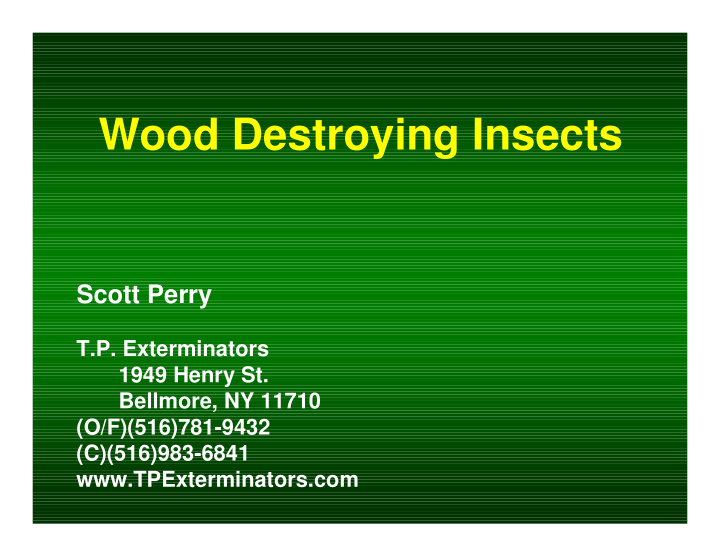



Wood Destroying Insects Scott Perry T.P. Exterminators 1949 Henry St. Bellmore, NY 11710 (O/F)(516)781-9432 (C)(516)983-6841 www.TPExterminators.com
Common Wood Destroying Insects Termites Carpenter Ants Powderpost Beetles Carpenter Bees
Termites Major destroyers of wood and wood product materials. Normally associated with buildings, but can also infest wood that has been stored for some time. There are three basic kinds of termites: Subterranean Dampwood Drywood
Easter Subterranean Termite Workers / Soldiers Reproductive's / Swarmers
Biology Live in colonies at water table level Typical colony size is about 700,000 to 1 million Termites are about 1/8 inch and cream in color A majority are blind sterile females Exoskeleton is a thin mucus membrane
Termite Damage Not typically noticed Termites have weak mouth parts creating slivering of wood “Dirt” found in wood Mud tubing found on foundation walls Compression of sill plate
Prevention No wood to soil contact Remove foam boards and grade stakes used in construction Rise sill plate at least 6” above ground Landscape plantings no closer than 2ft. from structure Shed all water off structure
Termites: sometimes called “white ants” because they are ant-like in form. Termites differ in antenna form and having 2 segments instead of 3. Ant or Termite? Figure 3-5
Subterranean termite colonies live in the soil from which they construct exploratory tubes (mud tubes) in search of wood.
Signs of Subterranean Termite activity. Mud tubing and “slivering” of the wood
Termite Swarming is usually the first evidence of an infestation noticed by most people.
Carpenter Ants Camponotus Figure 3-9
Biology Black & quite large (1/4-5/8) 3 segments (head, thorax and abdomen) Hair on the abdomen They work in a cast system However they are polymorphic – means workers are different sizes
Carpenter Ants build nests in wood, they don’t eat it!
Carpenter Ant Damage Contrary to popular belief Carpenter ants don’t eat wood They burrow wood out and live within it They prefer moist wood but don’t have to have it Their diet varies between sugars and proteins
Damage Continued When they burrow the wood out the create “frass” (wood shavings and insect parts) This “frass” is typically found in piles under an ejection hole They create galleries that they live in which are kept very clean
Prevention Repair leaks from the roof, windows and bathrooms Trim shrubs off the house at least 3 feet Trim tree limbs over hanging the house at least 6 feet Stack firewood off the house
Powder Post Beetles Three Families Lyctids Bostrichids Anobiids
The main sign of powderpost beetles is powdery sawdust.
Powderpost beetles turn wood to dust!
Lyctid powderpost beetles: Attack sapwood Attack hardwoods only, rarely maple Require 8% to 32% moisture
Anobiid powderpost beetles: Prefer old woods, 10-20 years old! Attack hardwoods and softwoods including maple Require 13% to 30% moisture
Wood-boring weevil, Hexarthum : Frass looks like powderpost beetles Attack hardwoods, including maple Require high wood moistures, often wet!
Biology They are all about 1/32 to 1/8 inches long These beetle larvae develop within wood They emerge from wood to mate typically only once a year. For this reason they are rarely seen They are typically found in older wood
Damage The most common signs are small exit holes in the wood surface These holes will be found in close proximity to each other Powdery “frass” sifting from the holes and this powdery “frass” within the wood Small piles of this “frass” below exit holes
Carpenter Bees
Biology They are large robust bees measuring between 1 and 1-1/2 inches in length They tunnel a near-perfect circle in wood measuring approximately ½ inch in diameter The female constructs the hole and the male defends this nest (hovering in front) They are typically most active in late summer and early fall They prefer un-painted, weathered wood The female stings the male does not
Carpenter Damage The tunnel goes straight in a few inches and then makes a 90 degree turn creating long tube In this tube she creates “cells” which will house 6-10 larva New adults emerge in August and September and begin to construct their own nests So you start with 1 or 2 bees one year and after 3 or 4 years they are everywhere They will weaken structural wood
Prevention Treat each individual tunnel opening with insecticide Seal opening with caulking compound Paint the bottom and back side of wood structures to deter these bees from nesting Seal wood within sheet metal A tennis or badminton racket are effective on killing these bees Use pressure treated wood or a synthetic composite on the exterior of the structure
Question & Answer Please remember that answers are only generalities. Please see me afterward for specific questions. Thank you for your time and attention. By the way … Scott Perry, Pres. T.P. Exterminators Office: (516)781-9432 / Cell: (516)983-6841 TPExtermin@aol.com
Recommend
More recommend